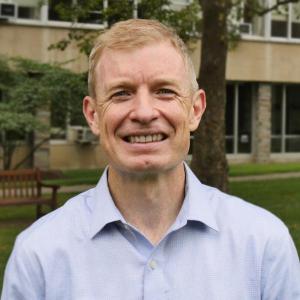Profile on Professor of Practice: Matthew Reiter

When Lance Collins, former Joseph Silbert Dean of Engineering at Cornell, announced the creation of the Professor of Practice title as a new category of faculty position in 2018, newly appointed Professor of Practice Matthew Reiter was exactly the type of professional Collins had in mind. Dean Collins said at the time, “We are excited to have this title available. It provides a way to bring a very different set of complementary skills to campus to add to our already stellar faculty. Now, people with deep experience in industry will have a chance to be part of the teaching corps of the university.”
Reiter, who joined the faculty of the School of Civil and Environmental Engineering in the summer of 2021, had close to twenty years of professional engineering experience before stepping foot in the classroom. He worked for the City of Chicago’s Bureau of Bridges; he was a Project Engineer for the engineering firm Thornton Tomasetti; and he held several positions in Cornell’s Facilities Engineering Department. Those years of experience inform his teaching and give him a perspective students find invaluable.
Fellow faculty members also appreciate Reiter’s deep pool of practical subject matter knowledge. “The faculty of CEE have been absolutely amazing,” Reiter said. “They are very much invested in me succeeding and it feels great.” In 2019, while still working as a structural engineer for Facilities Engineering, Reiter had the chance to teach the Introduction to Metal Structures class for Professor Chris Earls, who was on sabbatical at the time. Teaching that class was a revelation to Reiter. “I loved it,” he said. “I loved being in the classroom; I loved interacting with the students; I loved the projects. Above all, I loved being able to bring my experiences as a practicing engineer to the students and show them practical applications for what they were learning.”
When the idea of filling a Professor of Practice role in civil engineering was floated, Reiter jumped at the chance. Now that he is part of the faculty, he is focusing his teaching on behavior and design classes in steel, timber and masonry. Reiter is also leading the Master of Engineering (M.Eng.) program’s Structural Mechanics and Materials option.
It would be hard to find a teacher who believes more strongly in the power of structural engineers to affect the future. “We are in a position of influence with regards to not only how structures are built or modernized, but also what materials are used. It doesn’t get more essential than that,” Reiter said. “The world and its built environment are facing so many challenges with climate and sustainability and resilience, and structural engineers have the potential to make a major impact in these areas.”
The architectural style of Cornell’s Ithaca campus is hard to sum up with one word. You can find buildings from the 1860s to the 2010s and almost every decade in between. Reiter spent ten years getting to know those buildings and now he can use them as a living laboratory to help his students learn about structural engineering. “If I want my students to know about how a concrete slab would have been poured in 1910, they don’t have to read about it. We can go to the Bailey Rotunda and see for ourselves,” Reiter said. “And if we want to explore the implications of using modern Mass Timber construction, we can engage with the Facilities’ capital projects actively vetting its appropriateness for Cornell’s campus.”
Reiter is excited to be able to share what he has learned about structural engineering with the next generation of civil engineers, and is especially eager to be able to show them firsthand. In this first year in the classroom, he is teaching the Steel I, Steel II, Timber and Masonry classes to a mixed group of undergraduate and graduate students. When he is not prepping for class, teaching classes, grading assignments, or further developing the Structural Mechanics and Materials M.Eng. program, you can find Reiter roaming the sidelines at some of Ithaca’s youth basketball games, coaching his children as they play, or running through campus, always on the lookout for the next real-world case study to bring to his students.

